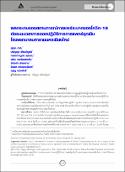บทคัดย่อ
ภูมิหลังและเหตุผล: การระบาดของโควิด-19 ส่งผลกระทบต่อระบบการดูแลผู้ป่วยหรือผู้บาดเจ็บนอกโรงพยาบาล วัตถุประสงค์: เพื่อศึกษาผลกระทบของสถานการณ์การแพร่ระบาดของโควิด-19 ต่อระยะเวลาในการออกปฏิบัติการการแพทย์ฉุกเฉิน โรงพยาบาลมหาราชนครเชียงใหม่ ระเบียบวิธีศึกษา: เป็นการศึกษาย้อนหลัง จากข้อมูลบันทึกปฏิบัติการฉุกเฉิน โรงพยาบาลมหาราชนครเชียงใหม่ ระหว่างเดือนเมษายนถึงเดือนกันยายน ในปี พ.ศ. 2562-2564 ศึกษาเปรียบเทียบการออกปฏิบัติการฉุกเฉินการแพทย์ในช่วงก่อนมีการระบาดและมีการระบาดของโควิด-19 ผลการศึกษา: พบว่าการให้บริการการแพทย์ฉุกเฉินในช่วงไม่มีการระบาด เริ่มการระบาดและมีการระบาดมีจำนวน 270, 255 และ 353 ราย ตามลำดับ จำนวนผู้ป่วยฉุกเฉิน (emergency dispatch triage) มีสัดส่วนที่เพิ่มขึ้นในแต่ละช่วงเวลา (ร้อยละ 40.4, 62.4 และ 66.6 ตามลำดับ) ระยะเวลาตั้งแต่รับแจ้งเหตุจนถึงรถพยาบาลพร้อมออกปฏิบัติการ (turnout time 71, 87, 167.5 วินาที, p < 0.001) ระยะเวลาตั้งแต่รับแจ้งเหตุจนถึงจุดเกิดเหตุ (response time 6, 7, 9 นาที, p < 0.001) และระยะเวลาตั้งแต่ออกจากจุดเกิดเหตุถึงโรงพยาบาลปลายทาง (back time 5, 5, 6 นาที, p = 0.004) ในกลุ่มผู้ป่วยฉุกเฉินเพิ่มมากขึ้นอย่างมีนัยสำคัญทางสถิติ, ตามลำดับ ระยะเวลาที่ใช้ในจุดเกิดเหตุ (scene time) ไม่แตกต่างกัน สรุปผลการศึกษา: การแพร่ระบาดของโควิด-19 มีผลกระทบกับระยะเวลาในการออกปฏิบัติการในระบบบริการการแพทย์ฉุกเฉิน การเตรียมความพร้อมของทีมปฏิบัติการ การจำกัดการทำหัตถการนอกโรงพยาบาลให้มีเฉพาะที่จำเป็นจริงๆ จะช่วยลดระยะเวลาในการออกรับและดูแลผู้ป่วยหรือผู้บาดเจ็บที่จุดเกิดเหตุได้
บทคัดย่อ
Background: The COVID-19 pandemic had an impact on the prehospital care system for sick or
injured patients in Thailand.
Objective: to assess how the pandemic influenced operation times within the emergency medical
service (EMS) system at Maharaj Nakorn Chiangmai Hospital.
Methodology: a retrospective study, analyzing emergency response records from April to September
in 2022 to 2024, comparing EMS operations before and during the COVID-19 outbreak.
Study Results: Prehospital care provision during the pre-pandemic, the initial outbreak, and the
outbreak periods, there were 270, 255, and 353 EMS cases, respectively. In the case of emergency dispatch
triage patients (red code), there was a substantial increase in the proportion of cases assigned to this
group during these periods (40.4%, 62.4%, and 66.6%, respectively). The EMS operation times exhibited
statistically significant increases, with increments of 71, 87, and 167.5 seconds for turnout time (p < 0.001);
6, 7, and 9 minutes for response time (p < 0.001); and 5, 5, and 6 minutes for back time (p = 0.004),
respectively. Nevertheless, no significant differences were detected in scene time across the three phases.
Conclusion: the outbreak of the COVID-19 pandemic significantly affected operation times in the
EMS system. Ensuring the readiness of response teams and implementing regulation on prehospital
procedures as necessary would effectively reduce response times and enhance prehospital patient care.


